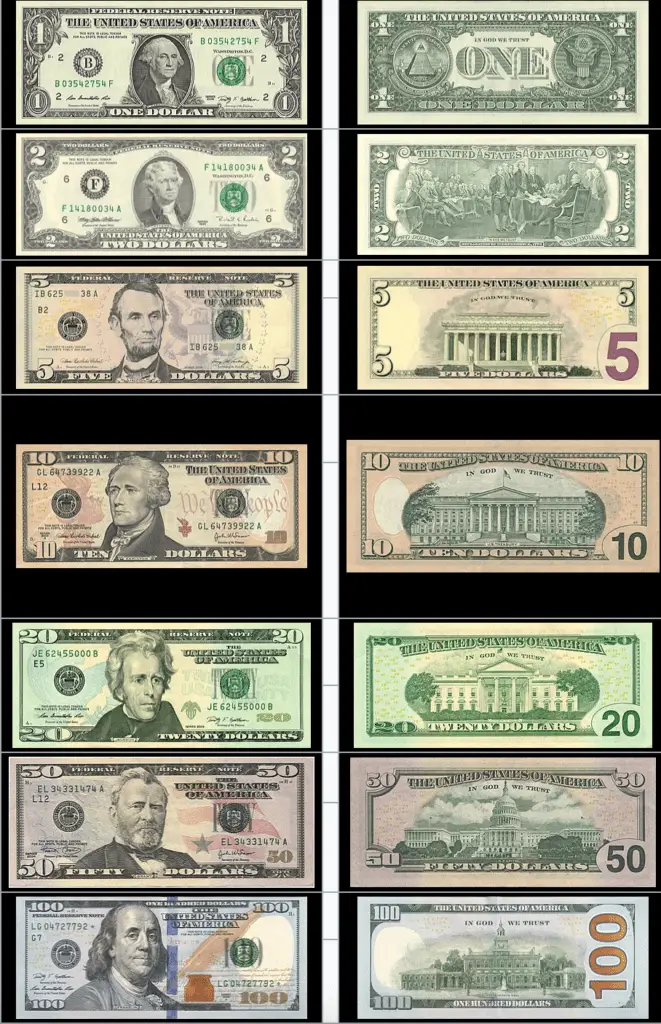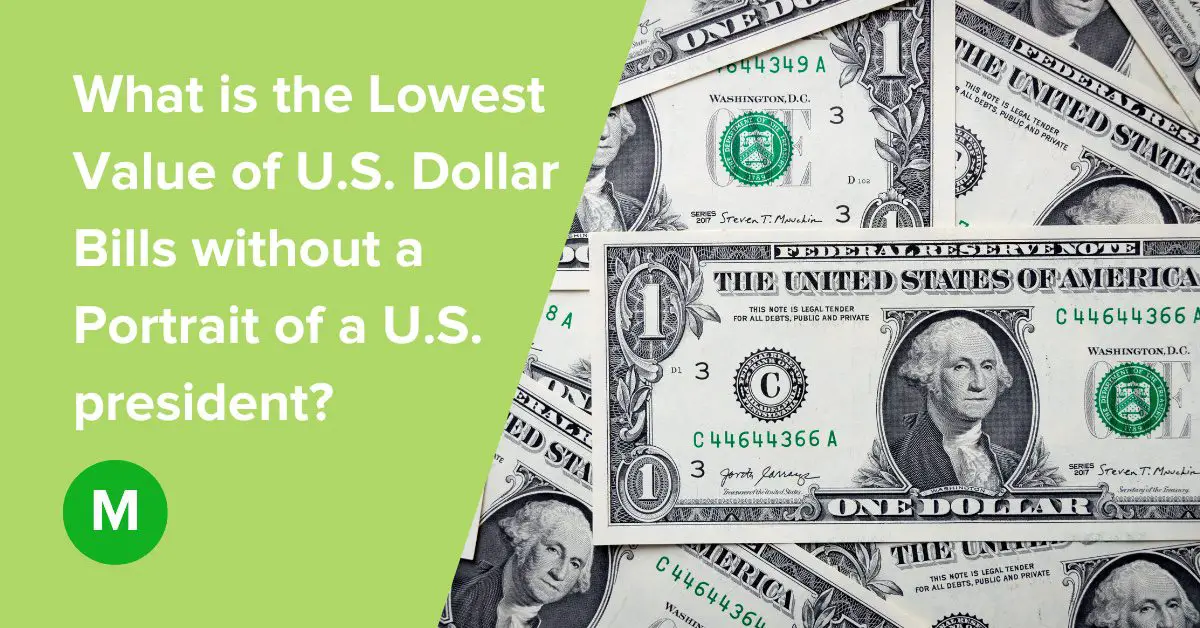What is the Lowest Value of U.S. Dollar Bills without a Portrait of a President?
The U.S. currency is undoubtedly one of the most influential currencies globally. Its value is ever-increasing, especially in third-world countries. But, one question lingers on many people’s minds: What is the lowest value of U.S. paper money without a portrait of a U.S. president?
Key Points
- The U.S. paper currency bears portraits of influential people in its history.
- Not all the portraits are of former presidents.
- Paper money does not have intrinsic value.
- The Secretary of the Treasury Department has a huge say on whose face appears on the currency.
This article searches for answers to this question. It will discuss dollar bills without a president on them, those with presidents on them, and those with faces of people who were never president. Let’s dig in!


Is there a dollar bill without a president on it?
First, most U.S. paper money bears the portrait of its former presidents. So, before looking at the dollar bills without a president on them, let’s remind ourselves of the ones with portraits.
The table below shows the list of paper money with portraits:
| President | Dollar bill |
| George Washington | $1 |
| Thomas Jefferson | $2 |
| Abraham Lincoln | $5 |
| Alexander Hamilton | $10 |
| Andrew Jackson | $20 |
| Ulysses S. Grant | $50 |
| Benjamin Franklin | $100 |
Who decided the faces of every U.S. dollar bill?
The Secretary of the Treasury Department has the final say on whose face will be printed on the U.S. paper money. However, the criteria they use to make the final decision are still unclear.
The Treasury Department claims that they give priority to people whose positions in history are known by the Americans. But, Federal Law prohibits the face of any living person from appearing on the U.S. Government Securities.
What dollar bills have no presidents?
However, two dollar bills don’t have a president on them. Do you know which ones they are?
- The U.S. $10 bill, which bears the portrait of Alexander Hamilton;
- The U.S. $ 100 bill which bears the portrait of Benjamin Franklin.
So, what is the lowest value of U.S. paper money without a Portrait of a U.S. president? Well, the winner is Alexander Hamilton on the U.S. $10 bill. It is also a unique bill in that it is the only denomination in circulation in which the portrait faces left. He is also the only person not born in the U.S. or British America that appears on the currency.
For current currency, Alexander Hamilton, first Secretary of the Treasury, is on the 10 dollar bill. Washington is on the $1, Jefferson is on the $2, Lincoln is on the $5. Next non-president is Ben Franklin on the $100. – said John Heagetry, Former CEO (ret) at Coakley Heagetry, 1970-2015
Who is Alexander Hamilton?
Alexander Hamilton is an American politician, legal scholar, military commander, economist, banker, and statesman. Born in Charlestown, Nevis, he was orphaned before a successful merchant took him in.
In his teenage years, he went to New York to pursue his education. He also participated in the militia of the American Revolutionary War. He became a senior aide in 1777 to run the new continental army to General Washington.
Immediately after the war, he got elected as a representative to the congress of the Confederation from New York. He resigned from practicing law and joined politics after launching the Bank of New York. Having been a trusted member of President Washington’s first Canet, he was also the head of the treasury.
Who is on currency that was never a president?
Apart from Benjamin Franklin and Alexander Hamilton, several other people were not presidents that were on the U.S. currency. Who are these esteemed persons whose portraits appear on U.S. currency?
Salmon P. Chase – $10,000 bill
Salmon P. Chase is a one-time Treasury Secretary in the Lincoln administration. He was an ambitious politician who served as a Governor of Ohio and a U.S. Senator.
His face appears on the $10,000 bill that was first printed in 1918. However, the bill was discontinued in 1969 by the Fed and Treasury.
Spencer M. Clark – 5 Cent Note
Spencer M. Clark was a Superintendent of the National Currency Bureau in 1862. He is responsible for developing the original Treasury Seal. Besides that, he was the one designing and producing notes in 1864.
In the process, he added a 3-cent note to the initial four denominations. Instead of repeating portraits of previously used presidents, he went for his own. Smart, huh?
Other notable personalities on U.S. currency notes are:
- William P. Fessenden – 25 Cent note
- Francis E. Spinner – 50 Cent note
- First Lady Martha Washington – Silver Certificate $1 bill issued in 1886
What paper money is Abraham Lincoln’s face on?
President Abraham Lincoln’s face is on the Five Dollar Bill. The dollar bill dates back to 1914 and has always had the face of the 16th president of the United States. It has been redesigned severally, but the portrait remains the same.
What is the lowest dollar bill?
According to the United States Currency, American paper currency has seven denominations. $1, $2, $5, $10, $20, $50, $100. The U.S. no longer issues bills in larger denominations such as $500, $1000, or $5000.
But, they may still be in circulation and are legal tender. You can redeem all U.S. currency issued from 1861 at their full face value. In this regard, the lowest dollar bill is the $1 bill.
Does paper money have no value?
First, paper money, also called “fiat” money, does not have intrinsic value. Supply and demand determine the value of paper money. The government decree declares paper money as legal tender.
Therefore, the paper money’s value is determined by its demand. You determine the value of money by what people exchange for it and by how much of it is available. Therefore, when the value of money decreases, the cost of goods usually increases. This is what is called inflation.
However, the fiat currency has to maintain certain properties for people to believe it, transact in it, store it, lend it and accept it in payment.
- Medium of exchange
- Store of value
- Unit of account
In this sense, this quote sums it up well:
Money is a promise. The piece of paper is just the record of a promise. It has value not for itself but for what it represents. Like title deeds or passports. – said Alec Cawley, Software Engineer.
Conclusion
Now you know that Alexander Hamilton on the U.S. $10 bill is the lowest value of U.S. paper money without a Portrait of a U.S. president. Although the U.S. paper currency generally has portraits of former U.S. presidents, Alexander Hamilton and Benjamin Franklin are exceptions.







